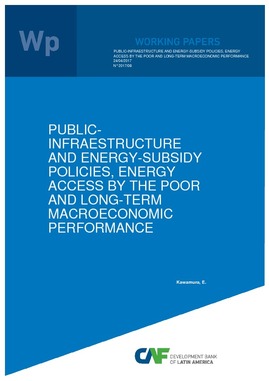Public-infraestructure and energy-subsidy policies, energy access by the poor and long-term macroeconomic performance
Resumen
This paper presents the main set-up and long-run results from a simple deterministic version of a dynamic stochastic general equilibrium model of a small open economy in Kawamura (2017). The model assumes two types of households, one poor and the other non-poor. There are two types of energy used as both GDP input and consumption goods, one using a fossil-based resource (with a given international price) and another that uses public capital and that represents a non-standard, "clean" (i.e., non-fossil based) energy source. The paper reports the results from two types of policy makers. The .rst type corresponds to a benevolent and perfectly-committed government that sets complete plans of taxes, subsidies and public investment policies, including public infrastructure. The second type of policy maker is a politician that wins elections occurring in every period. Such politician implements policies promised at the electoral stage. This second policy-making process assumes that the politician can commit to policies only for the period in which she wins elections. The paper shows that a necessary condition for obtaining long-run growth in public capital, private capital, GDP and clean energy is that the international price of the resource increases steadily through time. Thus, both types of policy makers react to such increase by also steadily increasing the public investment.
Materia
Fecha
2017-04-24Citar de esta publicación
Item perteneciente a la Colección
Items Relacionados
Estimating the nature of political corruption: evidence from a policy experiment in Brazil
This paper proposes a test to estimate the nature of political corruption in developing countries: embezzlement by self enriching politicians versus ...
Spatial inequalities in educational opportunities: The role of public policies
This paper documents spatial patterns in intergenerational mobility at the top of the educational distribution and assess the role of public policies ...
Greenflation: The cost of the green transition in small open economies
We propose a new model of a small open economy with efficient energy use to investigate the inflationary dynamics along the green transition. The model ...






